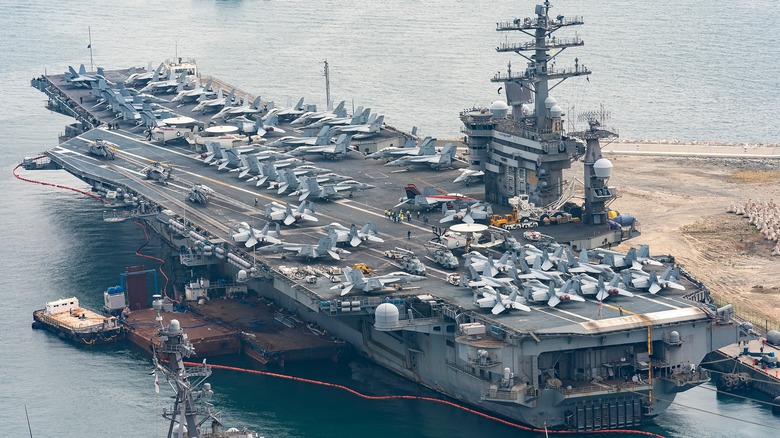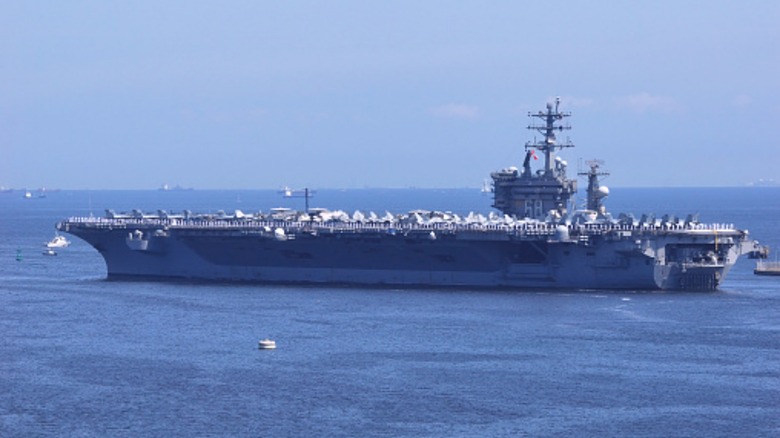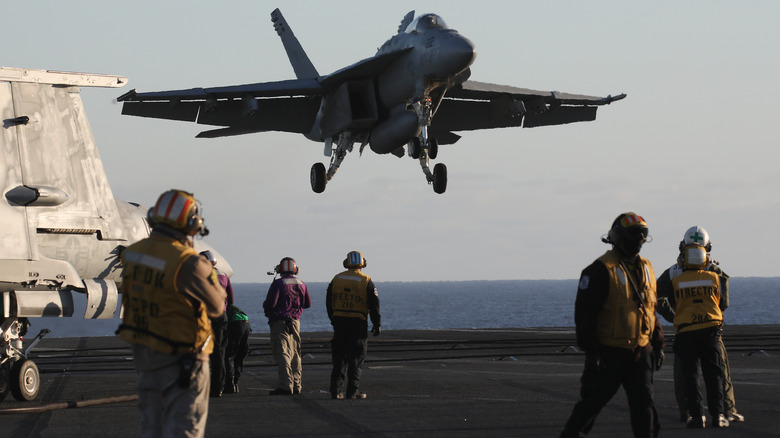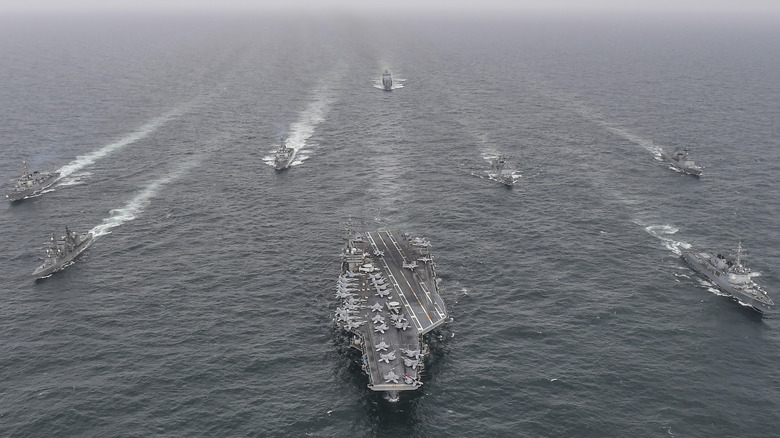
Parkdolly/Shutterstock
It didn’t take long after the Wright Brothers first took flight for someone to dream that airplanes might be useful for warfare. But without lengthy fuel range, transporting the planes before missions became critical. As a result, the first flight from the deck of a Navy ship occurred in 1910, and for the next few years, different experiments proved the viability of taking off and landing on a ship at sea. The first true aircraft carrier built for … well, carrying aircraft, came in 1918 with the commissioning of the HMS Argus.
As conflict erupted further, designs improved, making aircraft carriers some of the most essential vessels during WWII. And it remains true to the day. Modern aircraft carriers feature a variety of designs that share several key characteristics. These vessels often cost billions to build and millions to maintain, so most countries try to get as much use out of them as possible. As a result, many of the carriers afloat today have been in service for decades.
This begs the question, ‘What is the oldest aircraft carrier that remains in service?’ The simple answer is the USS Nimitz (CVN-68), which was the first of the Nimitz-class carriers. The long answer delves into the ship’s history, its importance to the modern design of aircraft carriers, and the many missions it’s undergone since it was commissioned on May 3, 1975.
The history of the USS Nimitz (CVN-68)

Viper-zero/Getty Images
The USS Nimitz began construction during the Vietnam War and entered active service soon after the war ended. It is named after WWII Pacific fleet commander Chester W. Nimitz and is the first of ten Nimitz-class aircraft carriers to enter active service. The design of the Nimitz incorporated numerous changes based on lessons learned from the previous Kitty Hawk, Forrestal, and Enterprise classes.
Some of the vessel’s features include using two reactors instead of the eight found on the USS Enterprise. This enabled the Nimitz to carry 90% more aviation fuel as well as 50% more ordnance than its predecessors. Additionally, the Nimitz uses steam catapults and arrestor wires to launch and recover aircraft. This system made it possible to more efficiently and expeditiously launch sorties, maximizing the Nimitz’s combat capabilities.
The Nimitz and the nine other vessels in its class incorporated various design enhancements to combat growing tensions during the Cold War, focusing on using nuclear power to maintain blue-water supremacy. Because of this, the Nimitz can remain at sea for two decades without refueling, and its initial lifespan was set at 50 years. Of course, the Nimitz didn’t go to sea for 20 years, return, and head back out, but the capability to do so existed, reducing the need to return to port as often as earlier non-nuclear carriers.
The Nimitz’s actions around the world

Mario Tama/Getty Images
The USS Nimitz’s first deployment to the Mediterranean Sea occurred in 1976, but it didn’t take part in any major actions. It did, however, demonstrate its status as the most efficient aircraft carrier operating in the Atlantic Ocean when it was awarded the Battle Effectiveness Award, otherwise known as the Battle «E» from Commander, Naval Air Force, U.S. Atlantic Fleet. Not much happened with the Nimitz in the 1970s, but in 1980, it took part in Operation Eagle Claw, the failed operation to rescue 52 embassy staff from Tehran, Iran, held during the Iran hostage crisis. The Nimitz launched eight RH-53D helicopters, but the operation ultimately failed.
In the ’80s, the Nimitz was the site of a significant crash, resulting in the deaths of 14 crewmen. Its aircraft later engaged two Libyan jets in the Gulf of Sidra incident, and in 1985, the Nimitz’s aircraft bombed sites in Beirut, Lebanon, following a hijacking. In the ’90s, the Nimitz deployed in support of Operation Desert Storm and Operation Southern Watch, projecting U.S. military might throughout the Middle East.
In the aughts, the Nimitz returned to the Persian Gulf to participate in Operations Iraqi Freedom and Enduring Freedom. Aircraft from the Nimitz participated in combat operations over the skies of Iraq and Afghanistan. The Nimitz returned to the region several times throughout the conflict and also hit targets in the conflict against ISIS in Iraq and Syria in the 2010s. She continued sailing on various deployments around the world into the 2020s, and in 2023, it completed its 350,000th arrested aircraft landing.
The future of the USS Nimitz

Handout/Getty Images
The USS Nimitz spent decades at sea, but it’s not exactly the same ship it was in 1975. Each time it went in for refueling, it also underwent overhauls. The first of these occurred from 1983 to 1984, with the second from 1998 until 2001. Each time the ship is overhauled, it’s given the latest tech to bring it up to speed with the other vessels in its class. While there are 10 Nimitz-class aircraft carriers, the design changed throughout the building process, which concluded in 2006 with the USS George H.W. Bush (CVN-77).
That ship is more advanced now than on its first deployment. Unfortunately, despite its extensive service record and retained combat capabilities, the Nimitz won’t remain in operation forever. The U.S. Navy switched to new Ford-class carriers with the USS Gerald R. Ford (CVN 78) commissioning in 2017.
As of 2024, the USS Nimitz has been in service for 49 years, but it was initially slated for retirement in 2022. That didn’t happen, and its new end-of-life date is expected to be sometime in fiscal year 2026, which begins in October 2025. It takes some time to decommission an aircraft carrier like the Nimitz, so it wouldn’t become inactive until 2027 if the plan holds. Once decommissioned, which is a costly and difficult process, the Nimitz will retire to Newport News, Virginia.